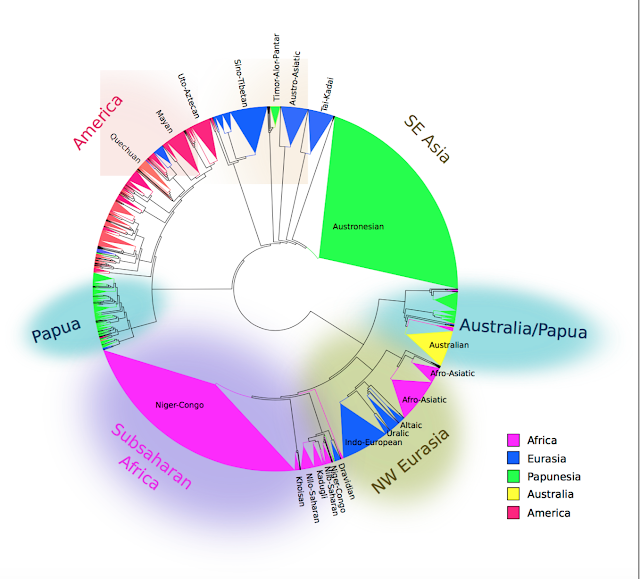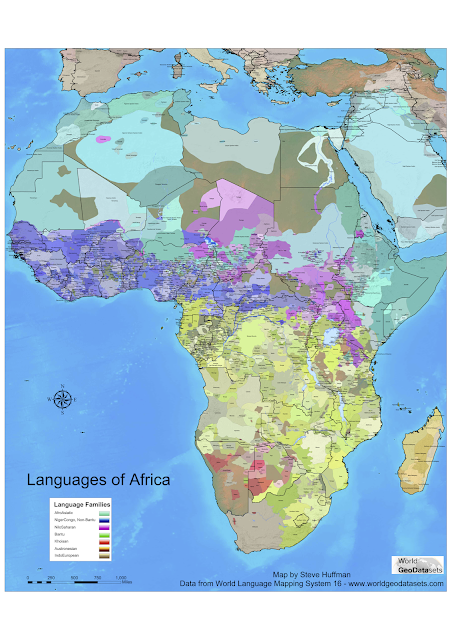Diachronic and functional explanations of typological universals @ SLE2016
The last two days I attended the workshop "Diachronic and functional explanations of typological universals" at the 49th Annual Meeting of the Societas Linguistica Europaea in Napels, Italy. This theme session was organized by Natalia Levshina, Ilja Serzant, Susanne Michaelis and Karsten Schmidtke-Bode, the description can be found here (page 409-410) and the introduction can be found here.
The purpose of the workshop was to draw attention to the importance of diachronic explanations for typological universals. Typological universals were also the topic of Jeremy's last post. They are properties found in (nearly) all languages, or if not all, enough languages to deserve an explanation. Jeremy discusses word order universals, an example being that if a language has verb-object word order, it is also likely to have prepositions, i.e. to have adposition-noun order (see Matthew Dryer's map in the World Atlas of Language Structures Online). Many explanations proposed for universals have been 'functional': verb-object and adposition-noun, for instance, would pattern together because they branch in the same direction, and this is easier to process than structures which do not match in this regard (Dryer 1992). There are many more examples of studies who explain typological correlations in terms of ease of processing, comprehension, production, and (first language and second language) learnability.
As the conveners of the workshop note, an alternative view on explaining universals comes from the history (diachrony) of languages. This is also the point of Jeremy's post: showing that at least some word order universals can be explained through highly common grammaticalization pathways rather than the pull of processing or learnability constraints.
It is really unfortunate that for some time now, linguistic typology and historical linguistics are conceived of as quite different and separate enterprises. Shibatani and Bynon (1995: 20-21) describe that this disunion came about when transitions between the famous morphological "stages" of isolation, agglutination, and fusion proved unfalsifiable in the sixties. Later on, Givón and Greenberg would pave the road towards an integration of typology and historical linguistic. This integration has not fully been achieved, however. Handbooks on linguistic typology often include a chapter on language change, but they don't give language change the central role it should have in order to advance the field.
During the Napels workshop, it became clear that all participants (mostly typologists looking at various morpho-syntactic features) feel the need for further development of historical explanations of typological patterns and universals. This includes Sonia Cristofaro, first and foremost, who has published extensively on this topic. See also her interview with Martin Haspelmath.
Other participants with a historical outlook were Eugen Hill, who described a diachronic rather than a functional explanation of Watkin's law; Eitan Grossman, who presented multiple grammaticalization pathways through which agent nominalizers (such as '-er' in 'kill-er') come about; and Michael Cysouw, who proposed an extension of Maslova (2002) in order to study transition probabilities between states, rather than frequencies of states.
Other participants emphasised the role of functional explanations. First and foremost, this includes Susanne Michaelis and Martin Haspelmath, the latter of which argues for a functional-adaptive constraint that guides diachronic change in general, and during this workshop together they proposed this constraint to explain the difference in length between independent personal pronouns (mine as in 'the book is mine') and dependent personal pronouns (my as in 'my book'). (See also Martin Haspelmath's post on this topic on his blog Diversity linguistics comment).
Other participants with a functional outlook were Ilja Seržant, who defended a functional account of the rise of differential object marking in Old Russian; Anita Slonimska and Seán Roberts (who won first prize for best PhD presentation!), who showed that question words are similar in order to facilitate early speech-act recognition; and Paul Widmer et al., who present a phylogenetic comparative study of the stability of recursion of the Indo-European noun phrase, a result that can only be explained through a neurophysiological preference for recursion.
Then there was a set of participants who proposed links between history and functional explanations: Olga Fischer, who discusses the role of analogy in grammaticalization; Borja Herce Calleja, who shows that past and future time deictic adverbials (like 'ago' (past) and 'in X years time' (future)) have different diachronic sources, which could be explained by the cognitive and experiential gap between past and future; and my own talk with Andreea Calude, which considered diachronic and functional explanations of atom-base order of numerals in Indo-European.
The most interesting work, at least in my opinion, was presented by Balthasar Bickel and Damián Blasi, Natalia Levshina, and Karsten Schmidtke-Bode. These three presentations all attempted to explain typological patterns through synthesis not only of typological and diachronic data, but data from experiments, corpus studies, gesture studies, and information structure. Balthasar Bickel and Damián Blasi presented an account of the preference for unmarked initial noun phrases to be either S ("subject") or A ("agent") arguments using findings from the neurophysiology of language processing, phylogenetics, and gesture studies. Natalia Levshina explained typological distributions of lexical, morphological, and analytic causatives through economy principles, using evidence from a corpus study, a typological study, a language learning experiment, consideration of diachronic pathways, and frequency effects. Karsten Schmidtke-Bode presented findings on diachronic pathways, iconicity, information structure and corpora to explain the placement of S ("subject") and A ("agent") complements.
These three talks where the most impressive to me, as the best bet we have in explaining typological patterns is to incorporate as many different types of data we can get. This was summed up rather nicely in Balthasar Bickel and Damián Blasi's conclusion. In my wording, they state that in order to explain diachronic universals, we need:
- a theory of common evolutionary pathways (grammaticalization)
- a theory of aspects that constrain random evolution: i.e. 'functional' needs from communication, processing, production, learnability, etc.
Hence, the two themes of the workshop are really two sides of the same coin. This is not a new conclusion, see for instance Jadranka Gvozdanović who writes in 1997 "a theory of language history is explanatorily adequate to the extend that it is able to correlate attested language data with types of language activity whose consequences they are" (Gvozdanović 1997). However, we may now have tools (demonstrated by various participants of the workshop) as well as ever increasing data sets that can be used to provide a holistic account of language universals. The role of grammaticalization in this endeavor is central, as Jeremy noted earlier, and very interesting in light of Shibatani and Bynon's description of the state of the art in 1995: "But we do not now see grammaticalization as a mechanism which propels entire languages from one type to another" (Shibatani and Bynon 1995: 21). This has obviously changed, and so much the better for our understanding of typological and historical patterns.
Dryer, Matthew S. 1992. The Greenbergian word order correlations. Language, 68(1). 81-138.
Gvozdanović, Jadranka. 1997. Introduction. In Gvozdanović, J. (ed.), Language change and functional explanations 1-8. Berlin: Mouton de Gruyter.
Maslova, Elena. 2002. Distributional universals and the rate of type shifts: towards a dynamic approach to "probability sampling". Lecture given at the 3rd Winter Typological School, Moscow. Available online at http://anothersumma.net/Publications/Sampling.pdf
Shibatani, Masayoshi, & Bynon, Theodora. 1995. Approaches to language typology: A conspectus. In Shibatani, M. & Bynon, T. (Eds.), Approaches to language typology 1-26. Oxford: Oxford University Press.





Comments
Post a Comment